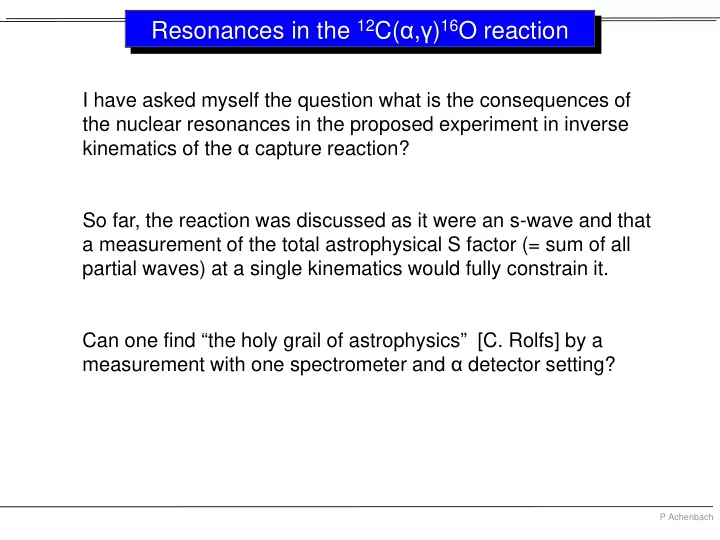

Resonances in the 12 C( α , γ ) 16 O reaction I have asked myself the question what is the consequences of the nuclear resonances in the proposed experiment in inverse kinematics of the α capture reaction? So far, the reaction was discussed as it were an s-wave and that a measurement of the total astrophysical S factor (= sum of all partial waves) at a single kinematics would fully constrain it. Can one find “the holy grail of astrophysics” [C. Rolfs] by a measurement with one spectrometer and α detector setting? P Achenbach
Existing S factor data E1 ground state E2 ground state transition transition 1 - 2 + transition into 7.12 MeV state transition into 6.92 MeV state D. Schürmann, L. Gialanella, R. Kunz, F. Strieder: The astrophysical S factor of 12 C( α , γ ) 16 O at stellar energy, Phys. Lett. B 711, 35 (2012) P Achenbach
Schematic S factor curves the cross section at stellar energies is, most likely, dominated by the tails of subthreshold resonances corresponding to the bound states at 7.12 MeV and 6.92 MeV, whereas in the experimentally accessible region it is dominated by the resonance corresponding to a 9.6 MeV state and by direct capture constructive or destructive interference may occur. the total cross section is incoherent sum of E1 and E2 leading to four possible curves depending on the sign of the interference effects. C. E. Rolfs & W. S. Rodney: Cauldrons in the Cosmos, Chicago: Univ. Chicago Press (1988) P Achenbach
Extrapolated S factor curves recent calculations for the different contributions to the S factor of the reaction and current precision. → Δ S/S ~ 12 % D. Schürmann, L. Gialanella, R. Kunz, F. Strieder: The astrophysical S factor of 12 C( α , γ ) 16 O at stellar energy, Phys. Lett. B 711, 35 (2012) R. Kunz et al.: Astrophysical Reaction Rate of 12 C( α , γ ) 16 O, Astrophys. J. 567, 643 (2002) P Achenbach
How to improve? R. Kunz et al.: Astrophysical Reaction Rate of 12 C( α , γ ) 16 O, Astrophys. J. 567, 643 (2002) D. Schürmann, L. Gialanella, R. Kunz, F. Strieder: The astrophysical S factor of 12 C( α , γ ) 16 O at stellar energy, Phys. Lett. B 711, 35 (2012) P Achenbach
How to approach experimentally? C. E. Rolfs & W. S. Rodney: Cauldrons P. Prati et al.: Nuclear Astrophysics At LUNA: in the Cosmos, Chicago: Univ. Chicago Status And Perspectives: Press (1988) p-wave “The measurement of the 12 C( α , γ ) 16 O reaction should be done in a nearly 4 π geometry d-wave with an angle-segmented crystal ball detector. The measurement of angular distributions is necessary to separate the E1 and E2 components of both ground-state and cascade transitions.” P Achenbach
Consequences It is important to get data of high relevance with respect to the (complex) properties of the S factor curve: What’s the impact of a data point on total d σ /d Ω at a specific cos θ • especially at E » E 0 where an extrapolation to E 0 is needed? − It is not possible to get σ total (and therefore S total ) from d σ /d Ω . − It is not possible to separate multipoles. − The cascade γ -decay amplitude is not accessed by the inverse reaction • Is it crucial to get information on p- or d-waves? • Requirement to get a measurement with 10-20% accuracy. P Achenbach
Consequences What is the ideal experimental setup? A limited (or integrated) detection angle of the α particle leads to an • unknown multipolarity of the measured cross section. • A detector ring or sphere with full angular coverage would have dramatically different background as a function of cos θ . • Is a gas detector a possible alternative to a detector? − A low pressure MWPC or multistep chamber can have a good timing resolution and high efficiency for nuclei while being extreme insensitive to gamma, electron, proton and neutron background − 4 π acceptance in a 1-3 Torr gas volume − see for example: K. Assamagan et al: Time-zero fission-fragment detector based on low-pressure multiwire proportional chambers, Nucl. Instr. Meth. Phys. Res. A 426, 405 (1999) P Achenbach
Helium burning reaction chain C. E. Rolfs & W. S. Rodney: Cauldrons in the Cosmos, Chicago: Univ. Chicago Press (1988) P Achenbach
Level scheme of the 16 O nucleus α (J p =0 + ) + 12 C (J p =0 + ) cross • section, σ (E 0 ), is dominated by p -wave (E1) and d -wave (E2) radiative capture to 16 O ground state (J p =0 + ) • Two bound states, at 6.92 MeV (J p =2 + ) and 7.12 MeV (J p =1 – ), with sub-threshold resonances at E R =-0.245 and -0.045 MeV, provide most σ (E 0 ) through their finite widths Transition 1 – → 0 + (E1) and • transition 2 + → 0 + (E2) distinguished by γ -angular D. Schürmann, L. Gialanella, R. Kunz, F. Strieder: The astrophysical S distributions factor of 12 C( α , γ ) 16 O at stellar energy, Phys. Lett. B 711, 35 (2012) P Achenbach
Recommend
More recommend